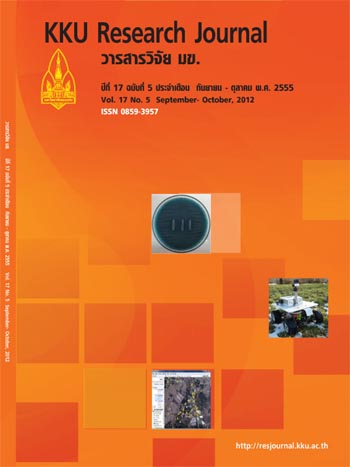Use of rice hull hydrolyzate in the cultivation of lactobacillus acidophilus
Main Article Content
Abstract
This project aims to minimize the cost of production of live L. acidophilus by replacing the expensive carbon source in the fermentation medium with the rice hull hydrolyzate and compare the growth efficiency of the microbe in the rice hull formulated medium with the rich medium (de Man Rogosa Sharpe or MRS). Rice hull was hydrolyzed with diluted H2SO4 and HCl at various concentrations 0.25, 0.5 and 1% v/v at 120oC for 30 minutes. The hydrolyzate was further overliming with Ca(OH)2 and filter through the diatomaceous earth. The treatment with 0.5% and 1% HCl provided the reducing sugar of 23.05 and 27.45 g/L which were close to MRS broth of 20.88 g/L. The hydrolyzate from the treatment with 1% HCl was further mixed with MRS in the ratio of MRS: hydrolyzate of 25: 75 and 10: 90 v/v. The MRS mixed with the hydrolyzate in the ratio of 25:75 v/v gave the maximum specific growth rate (μmax) of 0.437 hour-1 which was comparable to the MRS broth of 0.424 hour-1. The biomass yield (Yx/s), dry weight and viable cell number on the formulated medium at 48 hours cultivation were 0.21 g/g, 2.61 mg/ml and 2.07 × 108 CFU/ml respectively in comparison to MRS at 48 hours cultivation which were 0.19 g/g, 3.07 mg/ml and 2.19 × 108 CFU/ml (viable cell number in MRS represented the maximum level at 9 hours) respectively. The total acidity produced by the culture in formulated medium and MRS were 1.461% and 1.761%. Although, the formulated medium from rice hull hydrolyzate reduced the production cost in term of medium requirement, the time required for obtaining the same amount of viable cells in the hydrolyzate was longer than using MRS as a sole medium.
Article Details
How to Cite
Todhanakasem, T., & Puanglamyai, N. (2017). Use of rice hull hydrolyzate in the cultivation of lactobacillus acidophilus. Asia-Pacific Journal of Science and Technology, 17(5), 778–786. retrieved from https://so01.tci-thaijo.org/index.php/APST/article/view/83288
Section
Research Articles


